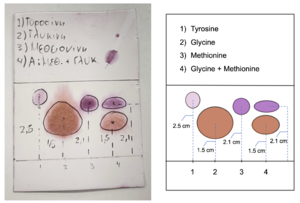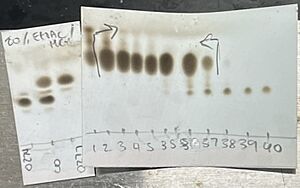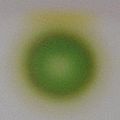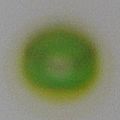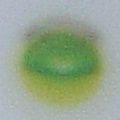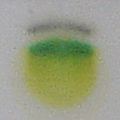Thin-layer chromatography facts for kids
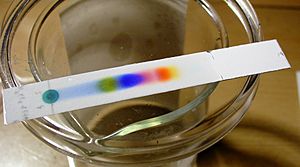
Separation of black ink on a TLC plate
|
|
| Acronym | TLC |
|---|---|
| Classification | Chromatography |
| Other techniques | |
| Related |
|
Thin-layer chromatography (TLC) is a cool science trick that helps separate different parts of a mixture. Imagine you have a mix of different colored candies, and you want to separate them. TLC does something similar for tiny chemicals!
It uses a special plate, like a thin, flat piece of glass or plastic. This plate is covered with a thin layer of a special powder, often called the "stationary phase." You put a tiny drop of your mixture near the bottom of this plate. Then, you dip the bottom of the plate into a liquid, called the "mobile phase" or "solvent."
This liquid then slowly moves up the plate, like water soaking into a paper towel. As the liquid moves, it carries the different parts of your mixture with it. Some parts of the mixture like to stick to the powder on the plate more, while others prefer to travel with the liquid. Because of these differences, the parts of the mixture separate and spread out into different spots on the plate.
If the chemicals are colorless, scientists can use special lights (like UV light) or stains to make the spots visible. TLC is super useful because it's quick, easy, and doesn't cost much. It helps scientists check how a chemical reaction is going, find out what's in a mixture, or even clean up small amounts of chemicals.
Contents
How to Do Thin-Layer Chromatography
Doing TLC is a bit like paper chromatography, but it's often faster and gives clearer results. You can even choose different types of powders for your plate! Here are the main steps:
Preparing Your TLC Plate
First, you take a small glass tube called a capillary tube. You use it to put a tiny drop of your mixture onto the TLC plate. You place this drop near the bottom edge. It's important to let the liquid in the drop dry completely before moving on. Sometimes, you might need to repeat this step to make sure there's enough of your mixture on the plate to see. You can also put several different mixtures in a row, creating separate "lanes" for each one.
Setting Up the Development Chamber
Next, you need a clear container, like a jar or a beaker. This is called the "development chamber." Pour a small amount of your special liquid (the solvent) into the bottom of this container, less than 1 centimeter deep. Put a strip of filter paper inside the container, touching the solvent and almost reaching the top. This paper helps the air inside the container get full of solvent vapor. This step is important for getting good, clear separation of your mixture. Then, put a lid on the container.
Developing the TLC Plate
Carefully place your TLC plate into the container. Make sure the spot where you put your mixture is above the liquid level, not dipped into it. Put the lid back on. The solvent will start to climb up the plate, carrying your mixture with it. This is called "eluting" the sample. You need to take the plate out before the solvent reaches the very top. Once you take it out, immediately mark the highest point the solvent reached. This is called the "solvent front."
Seeing Your Results (Visualization)
After you remove the plate, the solvent will evaporate. If your mixture parts are colorful, you'll see them as different spots. If they are colorless, you'll need a special way to see them. Common ways include looking at the plate under UV light or spraying it with a special stain that reacts with the chemicals to make them visible.
How Chemicals Separate on a TLC Plate
The magic of TLC happens because different chemicals in your mixture have different "attractions." Some chemicals are more attracted to the powder on the plate (the stationary phase), and some are more attracted to the liquid (the mobile phase). It's like a race where some runners prefer to stick to the track, and others prefer to run freely with the wind.
Because of these different attractions, each chemical travels up the plate at its own speed. This makes them separate into different spots. The type of solvent you use also makes a big difference in how well things separate. Scientists use something called the retardation factor (Rf) to measure how far a chemical travels. It's the distance the chemical spot moved divided by the distance the solvent moved.
Normal-Phase vs. Reverse-Phase TLC
There are two main types of TLC, depending on the kind of powder on the plate:
Normal-Phase TLC
In normal-phase TLC, the plate is covered with a "polar" powder, like silica gel. Think of "polar" as having a slight positive and negative side, like a tiny magnet. Chemicals that are also polar will stick more strongly to this polar plate. This means they won't travel as far up the plate (they'll have a smaller Rf value). Chemicals that are less polar won't stick as much and will travel higher up the plate.
If you use a more polar solvent, it will also stick to the plate more. This helps push the chemicals further up the plate. So, a "stronger" solvent makes all the spots move higher.
Reverse-Phase TLC
In reverse-phase TLC, the plate has a "non-polar" powder. This is the opposite of normal-phase. Here, non-polar chemicals will stick more to the non-polar plate and won't move as far. Polar chemicals will move higher up the plate. The solvents used in reverse-phase TLC are usually more polar.
Choosing the Right Solvent
Picking the right solvent is super important for good separation. Scientists often use a list called an "eluotropic series" to help them choose. This list ranks solvents by how much they make chemicals move.
Sometimes, a single solvent works well. But often, mixing two or more solvents together gives the best separation. For normal-phase TLC, common mixtures include ethyl acetate with hexanes for less polar chemicals, or methanol with dichloromethane for more polar chemicals. For reverse-phase TLC, solvents like water mixed with THF, acetonitrile, or methanol are common.
How TLC Plates Are Made
Most TLC plates are bought ready-made from companies. They are made by mixing a special powder, like silica gel, with a small amount of a harmless binder, like calcium sulfate (gypsum), and water. This mixture is spread out like a thick paste onto a flat sheet, usually made of glass, aluminum foil, or plastic.
The plate is then dried and "activated" by heating it in an oven. This makes sure the powder layer is ready to work. The powder layer is usually very thin for everyday use (about the thickness of a few sheets of paper) and a bit thicker for separating larger amounts of chemicals. Other powders like aluminium oxide or cellulose can also be used.
What TLC Is Used For
TLC is a very versatile tool in chemistry labs.
Monitoring Reactions and Identifying Chemicals
TLC is great for checking if a chemical reaction is working. Scientists can put a drop of their starting material, a drop from their reaction mixture, and a drop with both on the same plate. After running the TLC, they can see if the starting material has disappeared and if new chemicals (products) have formed. This quickly tells them how far the reaction has gone.
TLC can also help identify an unknown chemical. You can run the unknown chemical next to a known chemical on the same plate. If they travel the same distance and look the same under UV light or with a stain, they might be the same chemical! However, sometimes different chemicals can end up in the same spot, so it's good to try different solvents to be sure.
Checking Purity and Cleaning Up Chemicals
TLC can show if a chemical sample is pure. A pure sample should only show one spot on the TLC plate. If there are multiple spots, it means there are impurities.
TLC is also useful for cleaning up small amounts of chemicals. After the chemicals separate into different spots on the plate, a scientist can carefully scrape off the powder that contains the desired chemical. Then, they can dissolve that chemical in a solvent, filter out the powder, and let the solvent evaporate, leaving behind the pure chemical. Large TLC plates with thicker powder layers can even separate more than 100 milligrams of material!
For bigger clean-up jobs, TLC helps scientists choose the best solvent mixture before using a larger technique called flash column chromatography. TLC can also help check the "fractions" (small collections of liquid) from column chromatography to see which ones have the pure chemical and which have impurities.
There's also a special type called "two-dimensional TLC." This uses a square plate and runs the TLC twice, turning the plate 90 degrees in between. It helps check if a chemical is stable on the plate or if it's breaking down.
See also
 In Spanish: Cromatografía en capa fina para niños
In Spanish: Cromatografía en capa fina para niños
- Radial chromatography
- HPTLC
- Column chromatography
Images for kids


